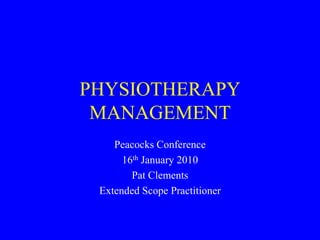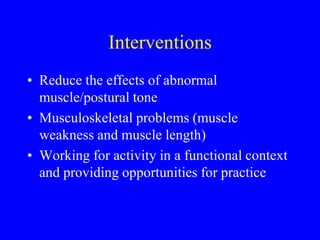Pat Clements
- 1. PHYSIOTHERAPY MANAGEMENT Peacocks Conference 16th January 2010 Pat Clements Extended Scope Practitioner
- 2. Recent Developments in Healthcare for Cerebral Palsy: Implications and Opportunities For Orthotics ispo.org.uk
- 3. Aims • Increasing or improving skill repertoire • Maintaining functional level • Management and minimisation of contracture deformities
- 4. Interventions • Reduce the effects of abnormal muscle/postural tone • Musculoskeletal problems (muscle weakness and muscle length) • Working for activity in a functional context and providing opportunities for practice
- 5. “Activity based approaches aim to prevent secondary muskuloskeletal impairments and maximise physical functioning, foster cognitive, social and emotional development of the child and develop, maintain and perhaps restore neural structures and pathways”
- 6. Interventions Not Recommended • Passive reflexive (massage) techniques • Passive stretching • Therapeutic Electrical Stimulation TES to increase function • Classical Bobath/neuro-developmental (NDT) – emphasis on normalisation of muscle tone – reflex inhibiting patterns
- 7. Interventions To be Recommended • Exercise activities that include active participation of the child to attain functional goals • Progressive resistance strength training • Use of assistive technology to promote mobility such as orthoses, wheelchairs, walkers or crutches.
- 8. Positioning • How long • Standing • Home or school • Team Approach • Practicalities
- 9. Function and Positioning • Positioning must allow child to play and participate. • May be able to achieve a few objectives with one position
- 10. Therapy • Incorporate into daily activities • Strength • Maintaining muscle length and joint range • Two joint muscles • Casting/orthotics • Endurance
- 11. Orthotics • Team Approach • Objectives • Prescription • Walking • Spinal • Hips • Contracture control devices
- 12. International Classification of Functioning Health Condition disorder or disease Body Function Activity Participation & Structures Environmental Personal Factors factors Contextual factors
- 13. PICO • Patient • Intereventions – therapy dependent on the goals of the family and child in consultation with evidence based family centered approach • Comparisons • Outcomes good outcome measures. Do outcomes match our goals












